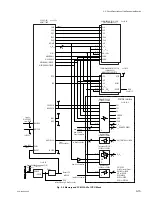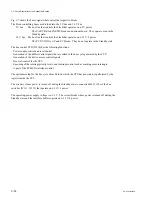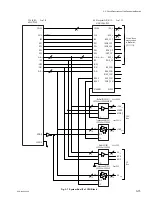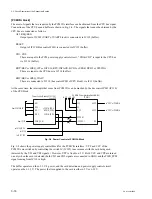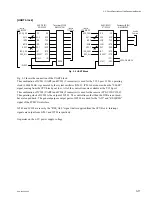
3-10
PCS-1500/1500P
Circuit Description of the Respective Blocks
The circuits of the respective blocks are described as follows.
[PWR block]
The following power voltages are generated from the
+
12 V DC that is supplied from the AC adapter.
+
3.3 V :
The
+
3.3 V power that is on at all times.
CPU block
+
5 V :
The
+
5 V power that is on at all times.
BRI, NETIF, SIRCS and UART blocks
Power for the PCMCIA interface
Power for the RX-47 board and to the optional boards
+
3.3 V-2 : The
+
3.3 V power that is turned off during standby.
PCMCIA, VCP, AC and EC blocks. The pre-filter section of the VIDAD block. The
graphics overlay section of the VIDDA block. The AD/DA converter of the AUANA
block.
+
5 V-2 :
The
+
5 V power that is turned off during standby.
The video decoder of the VIDAD block, video encoder of the VIDDA block, VIDIN
block, the 75
Z
driver section of the VIDOUT block
Power for the DE-54 board
+
10 V :
The
+
10 V power that is turned off during sleep and standby.
All sections of the AUANA block except the AD/DA converter section, low-pass filter
of the VIDOUT block
+
9 V :
The
+
9 V power that is turned off during sleep and standby.
Power for the DE-54 board
Fig. 3-5 shows the structure of the PWR block.
The
+
3.3 V power is generated by IC900 (step-down converter), the
+
5 V power is generated by IC901
(step-down converter), the
+
3.3 V-2 power and the
+
5 V-2 power are generated by IC902 (step-down
converter) and their peripheral FETs, inductors and capacitors by switching and smoothing out the
respective powers.
+
10 V power is generated by IC904 (regulator) and
+
9 V power is generated by
IC908 (regulator).
The
+
3.3 V-2 power and the
+
5 V-2 power are turned on and off by controlling IC902 (step-down
converter) using the “STANDBY” signal that is supplied from the CPU block.
The
+
10 V power and the
+
9 V power are turned on and off by controlling IC904 and IC908 (regulators)
using the “SLEEP” signal that is supplied from the CPU block.
The
+
12 V power that is required by the camera (PCS-C150/C150P) is supplied to the camera without
any process. (It is supplied through a fuse that is independent from the fuse for the power inside the PCS-
P150/P150P.)
The “POWER” and “STANDBY” indicator LEDs are controlled to turn on and off as shown below in
accordance with the “STANDBY” and the “SLEEP” signals that are supplied from the CPU block.
SLEEP signal
STANDBY signal
→
“POWER” LED
“STANDBY” LED
LOW
LOW
→
ON
OFF
Don’t care
HIGH
→
OFF
ON
HIGH
LOW
→
BLINK
OFF
Flashing the LED is performed by the oscillating circuit consisting of IC905.
The “STANDBY” indicator LED can be controlled to flash by the setting of the CPU in addition to the
illuminating conditions as described above. (It is valid only when the “STANDBY” LED is in OFF.)
3-2. Circuit Description of the Respective Boards
Summary of Contents for PCS-1500
Page 8: ......
Page 75: ...1 67 PCS 1500 1500P Sony Corporation Printed in Japan ...
Page 76: ......
Page 130: ......
Page 198: ......


















